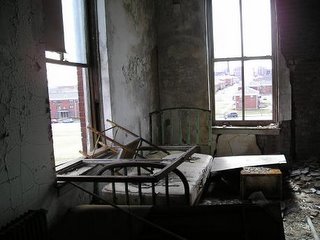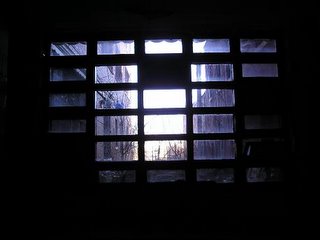St. Mary's Infirmary
 There are not many people that share my interest in exploring the forgotten places that few people get to see. Many people seem interested in my stories, or in photos of these historical places, but the idea of actually wandering into such a place just doesn't seem appealing to them. I have often been jealous of cities that have a tight knit group of explorers who share each other's zeal for these places, and wondered why a city as littered with forgotten history as St. Louis would have no such group. However, I am quite idealistic about the group that I met up with recently: Chris, Tunajive, and Inubis. This was my first time meeting Tunajive and Inubis (I had the pleasure of exploring the Falstaff Brewery with Chris), and I could tell right away
There are not many people that share my interest in exploring the forgotten places that few people get to see. Many people seem interested in my stories, or in photos of these historical places, but the idea of actually wandering into such a place just doesn't seem appealing to them. I have often been jealous of cities that have a tight knit group of explorers who share each other's zeal for these places, and wondered why a city as littered with forgotten history as St. Louis would have no such group. However, I am quite idealistic about the group that I met up with recently: Chris, Tunajive, and Inubis. This was my first time meeting Tunajive and Inubis (I had the pleasure of exploring the Falstaff Brewery with Chris), and I could tell right away  that they were as excited about exploration as I was.
that they were as excited about exploration as I was.We took only a moment to decide where the day's adventures would take us. I briefly looked over the site cards that Inubis had made that systematically plotted out all possible sites in the area that he had explored or wanted to explore (man, this guy was prepared!). I knew that Chris had already visited St. Mary's Infirmary, but did not get to finish his exploration because of an unsettlingly noisy vagrant on the floors above. Feeling safer in a large group, we decided that this was the day to return to the Infirmary.
The History of St. Mary's Infirmary is a long one. The property was purchased by the Sisters of St. Mary in 1877 with the intention of founding a small hospital. The first hospital building, which still exists today as the center portion of the old wing, was constructed in 1889 with additions in 1896 and 1906. Interestingly enough, this is the first hospital that SSM Healthcare traces the history of it's company back to. SSM now operates 20 Hospitals across Missouri, Illinois, Wisconsin, and Oklahom
 a. The other large wing was built in 1954, and is as one would expect in much better shape than the older portion. St. Mary's has had many functions over the years: It has operated as a hospital, a nursing home, a detoxification center, and a drug and alcohol rehab center. It now lies vacant and crumbling, with a large "For Sale" sign displayed on one of the fire escapes.
a. The other large wing was built in 1954, and is as one would expect in much better shape than the older portion. St. Mary's has had many functions over the years: It has operated as a hospital, a nursing home, a detoxification center, and a drug and alcohol rehab center. It now lies vacant and crumbling, with a large "For Sale" sign displayed on one of the fire escapes.Chris, Tunajive, Inubis, and I parked and began the short walk to the Infirmary. I don't have any data to prove my theory, but as the strong winds hit my face I was pretty sure that it was the coldest day EVER. I had to remind myself not to breath every time I took a photo, so that my breath wouldn't ruin the shot. It was so cold that Inubis had donned a green mask that covered all of his face except the eyes. With this on and his hood up, he look like some kind of weird ninja. We had to remind him that when one is trying to look inconspicuous, one doesn't want to look like a ninja. Chris quickly discovered a way in to the older addition. On his previous visit, he had seen the entire 1954 wing but only the basement of the older, more interesting wing. That was where we started.

Despite being abandoned for a considerable amount of time (the older building since probably around 1980), there is plenty of "stuff" left over. One of the first rooms I entered on the first floor had well over 30 toilets just sitting there. It made me scratch my head. Who took the time to assemble this army of porcelain, and why? As I wandered around the first floor, I was struck by how beautiful this building must have been in it's prime. Little things caught my attention, like the intricate design of the cast iron staircase, or the lovely tile designs on the first floor. Suddenly, my thoughts were interrupted. All at once, the four of us stopped and listened. There was obviously someone on one of the floors above us. We figured we would just continue our exploration and hope we didn't disturb whoever was above us. While we never ended up seeing someone in the Infirmary, signs that it was being used as a home by a number of people were apparent everywhere.

The higher we explored in the Infirmary, the more the floors became ruined and decayed. On the L-shaped addition in particular, one of the walls is crumbling and pretty much gone on every floor. On the sixth and last floor, we could see the floor below us in many places. We made sure only to step on the areas where we knew there were beams underneath. It was a slightly unnerving experience. It was on the top floor that we found a large metal machine with a round door on the side. "That must be an iron lung for babies," I heard someone say. We all laughed. "What else could it possibly be?" Chris, being the smart one as always, read the label and realized that it was
 an instrument sanitizer. So much for our iron lung theory! Convinced that we had seen all that this older wing had to offer, we began to search for a way into the 1954 addition.
an instrument sanitizer. So much for our iron lung theory! Convinced that we had seen all that this older wing had to offer, we began to search for a way into the 1954 addition.We wandered into the kitchen on the lowest level, and from there found our entry into the newer wing of the Infirmary. This wing is not nearly as interesting as the older one, with a more modern institutional design that must have been common in the 50's. All of the rooms and floors looked very similar. Upon reaching the second floor, we noticed that there was the distinct smell of something burning. We entered a corner room and saw that someone was warming food with a makeshift heater using a small fire in a tin cup. The fire was still burning, but there was no one to be seen. Not wanting to disturb someone's meal, we promptly left that area. The new wing had a few more oddities, such as a jail cell (I'm assuming this was used when the facility acted as a rehab center) and a small staircase that went nowhere, only to a wall.
 The fact that there are so many relics that hint at it's former life as a hospital make St. Mary's Infirmary especially interesting. I saw many old beds, a few wheelchairs, and even an ancient looking device for viewing x-rays. Although the many "living areas" made it apparent that we were the visitors here, I never felt uncomfortable. I was, however, glad that there were four of us. This is a remarkable site, and like many other crumbling landmarks in St. Louis, I would imagine someone will choose to do something with it soon. The latest information that I could find show the current owners planning 48 loft apartments and a possible restaurant. I know that I, for one, will be interested to see what the future holds for this forgotten site.
The fact that there are so many relics that hint at it's former life as a hospital make St. Mary's Infirmary especially interesting. I saw many old beds, a few wheelchairs, and even an ancient looking device for viewing x-rays. Although the many "living areas" made it apparent that we were the visitors here, I never felt uncomfortable. I was, however, glad that there were four of us. This is a remarkable site, and like many other crumbling landmarks in St. Louis, I would imagine someone will choose to do something with it soon. The latest information that I could find show the current owners planning 48 loft apartments and a possible restaurant. I know that I, for one, will be interested to see what the future holds for this forgotten site.
























0 Comments:
Post a Comment
<< Home